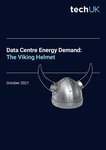At our DCD>Connect event, we sat down with Emma Fryer, the Associate Director for techUK to talk about the unlikely topic of Viking helmets. Upon realizing this was a metaphor, things became much clearer.
Viking helmets never had horns. It wasn’t until the 1870s when Carl Doepler added them to costumes that the myth was born. We now cannot even picture a Viking helmet without being adorned with two spikes.
The same has happened to the data center, we are being misdirected by myth.
“We're spending a lot of time talking about the wrong thing. We're arguing constantly about how many angels we can fit on the head of a pin, instead of actually getting on with what needs doing. So it ends up being a distraction, which I find quite frustrating.
“The last 10 years, I’ve been on the backfoot about people saying things about energy consumption in data centers and ICT more generally. I find myself always saying, ‘Well, actually, it's a bit more complex than that.’
“Back in 2007, you had Gartner saying that ICT produces the same emissions as the airline industry. Now, I knew where that was coming from. In the past year, the ICT industry had grown quite rapidly and the emissions were actually underreported, but the comparison doesn't bear any scrutiny. They were comparing the fuel used by the airline industry, with the fuel used in the whole lifecycle of carbon impact devices. They were comparing an industry that was something like five times the size of airlines and saying there was a problem.”
So how was the myth born? Emma argues that it was created from four angles of attack.
“The first one is actually the sort of data availability and quality. We don't have complete data. You don't report on data centers. In the UK, we report the commercial sector, but not enterprise. Nobody really reports it systematically; it's not in national energy registers. We don't have complete data, which means that people make it up, or use old data.
“The second reason, which I like better, is naughtiness. I call it naughtiness because everyone loves headlines. It's much more fun to tell people that we're all going to have to live in caves and eat bugs because of data centers than it is to say that data center energy is increasing incrementally, but that the carbon and energy productivity is amazing. That’s boring. You can see why that gets out there. Another thing is that we want a number, we want the number shorn of all the caveats, assumptions, and we end up misusing the numbers.
“Number three is profiteering. Not profiting, profiteering. ‘We’re all going to die, so buy this and it will help you. Buy this and it will solve your problems and make you a better person.’ We also get regulatory evangelism, which is this kind of the same thing. If you, as a regulator, can see a massive problem that you've got to solve and exaggerate the size of that problem, it justifies intervention. We have seen quite a bit of that.
“Finally, there are common errors. If you don't like the data centers because you calculate by working on the data that they are using 400 terawatt-hours of power in the UK per year, then check that against energy stats, the total energy, and electricity consumption of the whole of the UK in 2020. Remember the old schoolboy errors. Energy doesn't equal electricity. Megawatts don’t equal megawatt-hours. And the plastic bits are not the same as bytes.”
We have ended up with a bad reputation –an industry that is arguably causing more harm than good to the planet. But perhaps we can start to deconstruct the fiction and replace it with truth –- that as an industry, we are working towards a brighter and more sustainable future. We might not yet be there, but we are making progress.
More from techUK
-

Data center energy demand: the Viking helmet
A whitepaper exploring the myths surrounding data center energy demands
-

Discussion DCD>Talks Viking Helmets with Emma Fryer

